Learn the Basics of Core Drilling Concrete

Core drilling is a commonly used technique for creating holes in concrete. Whether you’re a professional contractor or a DIY enthusiast, understanding the basics of core drilling can be beneficial for any construction project. In this article, we will walk you through the essential steps and techniques involved in core drilling concrete.
What is Core Drilling?
Core drilling is a method used to penetrate solid materials like concrete, asphalt, or stone. It involves creating a cylindrical hole in the material with the help of a drill bit called a core bit. Core drilling is commonly used in construction projects to create openings for plumbing, electrical, or HVAC installations.
Why is Core Drilling Necessary?
Core drilling is necessary in construction projects for several reasons. It allows for the installation of pipes, cables, or conduits through concrete walls or floors. Core drilling is also used for sampling concrete to determine its strength and integrity. Additionally, core drilling can be used to create holes for anchor bolts or to remove damaged concrete for repairs.
As with any construction technique, core drilling requires proper planning, equipment, and safety precautions. It’s important to familiarize yourself with the process and use the appropriate tools and protective gear to ensure a successful and safe core drilling operation.
What is Core Drilling Concrete?
Core drilling concrete is a method used to create precise holes in concrete surfaces or structures. It involves using a specialized tool called a core drill, which is equipped with a diamond-tipped cutting edge. This cutting edge enables the drill to remove a cylindrical core of concrete from the desired location.
Core drilling is commonly used in construction, renovation, and maintenance projects where the creation of openings is necessary. It is often performed to install utilities such as plumbing pipes, electrical conduits, or HVAC systems. It can also be used to create openings for staircases, ventilation systems, or windows.
The process of core drilling involves several steps. First, the area where the hole will be drilled is marked and prepared. Then, the core drill is aligned with the marked spot, and the drilling begins. As the drill rotates and applies pressure, the diamond-tipped cutting edge gradually removes the concrete and creates a hole. Water is usually used to cool the diamond cutting edge and control dust during the drilling process.
Core drilling offers several advantages compared to other methods of creating holes in concrete. It is a highly accurate technique that allows for the creation of precise and uniform openings. The cylindrical cores removed during the process can also be collected and used for various purposes, such as testing the concrete’s strength or analyzing its composition.
Overall, core drilling is an essential method in the field of construction and offers a reliable way to create openings in concrete surfaces. Its versatility and precision make it a valuable tool for various projects, ranging from small home improvements to large-scale construction projects.
Understanding the Core Drilling Process
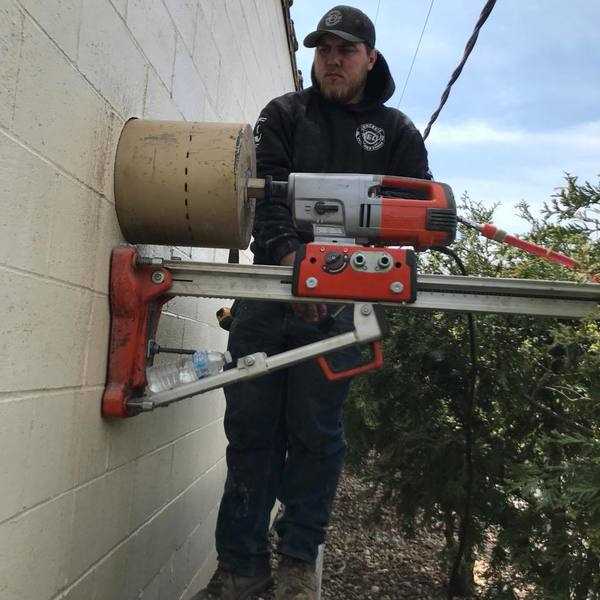
Core drilling is a commonly used technique in the construction industry to create precise holes in concrete and other solid materials. This process involves drilling cylindrical holes, known as cores, using a special drill bit called a core bit. Understanding the core drilling process is essential for anyone involved in construction or renovation projects.
1. Equipment and Tools
To carry out core drilling, several equipment and tools are required. These include:
- Core drill machine: This is a powerful drilling machine specifically designed for core drilling. It typically has a motor and a base that holds the core drill bit in place.
- Core drill bit: This is the specialized drill bit used for core drilling. It is made up of a hollow cylindrical tube with diamond-impregnated segments on the cutting edge.
- Water supply or a water source: Core drilling generates heat and can cause damage to the drill bit if not cooled properly. Water is used to cool the drill bit and remove the debris created during drilling.
- Safety gear: When performing core drilling, it is important to wear safety gear such as safety glasses, gloves, and ear protection to protect against dust, debris, and noise.
2. Process
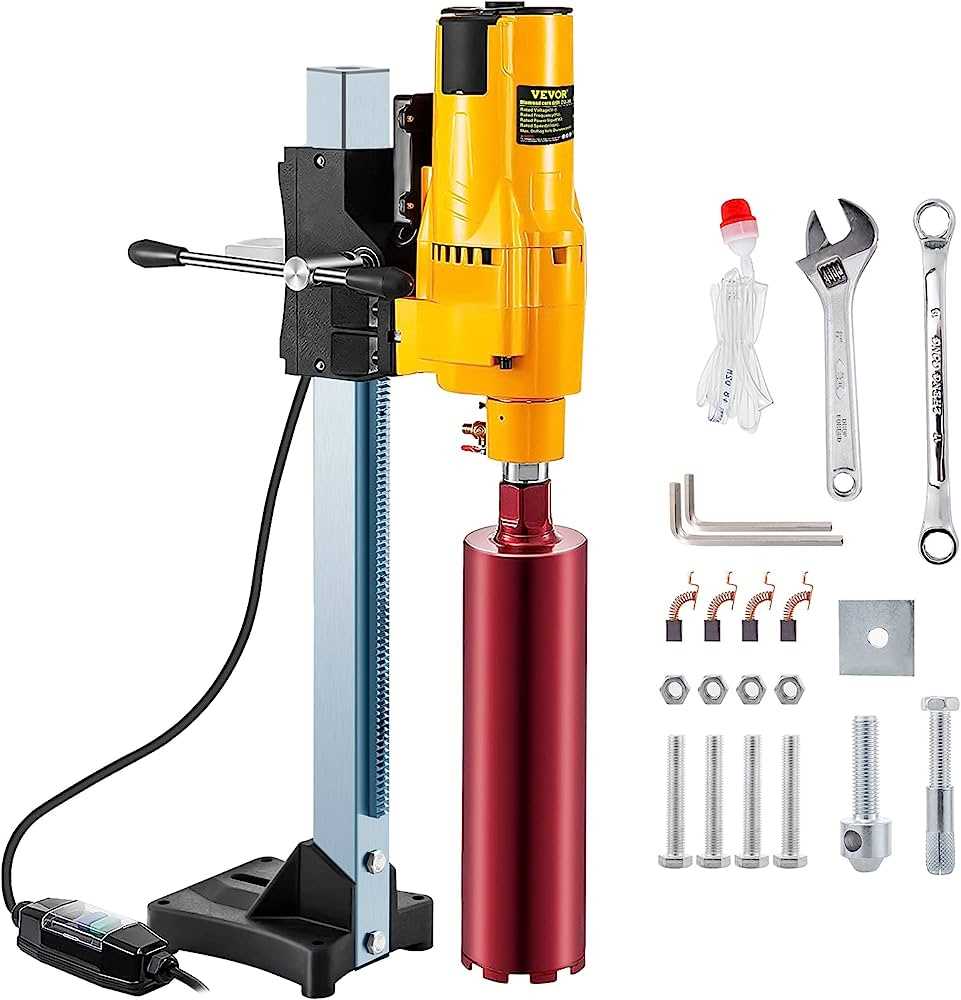
The core drilling process typically involves the following steps:
- Selecting the desired location: Determine the exact location where the hole needs to be drilled. Use measuring tools, such as a tape measure, to mark the spot.
- Preparing the area: Clear the area of any obstructions and ensure that it is free from dust, debris, or any other materials that may interfere with the drilling process.
- Setting up the core drill machine: Place the core drill machine on a stable surface and secure it in place. Ensure that the machine is properly aligned with the marked spot.
- Attaching the core drill bit: Select the appropriate size of the core drill bit and attach it to the drill machine. Make sure it is securely fastened.
- Starting the drilling process: Turn on the core drill machine and carefully start drilling into the concrete. Apply consistent pressure and use a steady, circular motion until the desired depth is reached.
- Cooling the drill bit: During the drilling process, continuously supply water to the drill bit to cool it down and flush away the debris. This helps to prolong the life of the drill bit.
- Removing the core: Once the drilling is complete, carefully remove the core from the hole. This can be done by using a core extractor or by inserting a pry bar into the hole and gently lifting the core out.
3. Safety Considerations
When performing core drilling, it is important to follow safety guidelines to prevent accidents and injuries. Some safety considerations include:
- Wearing proper safety gear, including safety glasses, gloves, and ear protection.
- Securing the work area and keeping it clear of any hazards.
- Ensuring the core drill machine is properly maintained and in good working condition.
- Using proper lifting techniques when removing the core.
- Using caution when handling the core drill bit, as it can be sharp and cause injuries.
By understanding the core drilling process and following safety guidelines, construction professionals can effectively and safely create precision holes in concrete and other solid materials.
Advantages of Core Drilling
Core drilling is a widely used method for creating holes in concrete. It offers several advantages over traditional drilling methods, making it a preferred choice for many construction projects.
Precision
Core drilling allows for precise and accurate hole drilling in concrete. The use of specialized drill bits and equipment ensures that the holes are made with great precision, minimizing the risk of errors and inaccuracies. This precision is particularly important when drilling holes for plumbing, electrical, or HVAC installations, as it ensures a proper fit and reduces the chance of leaks or other issues.
Efficiency
Core drilling is a highly efficient method for creating holes in concrete. The process is quick and requires less time compared to traditional drilling methods. This can significantly save time during construction projects, allowing for faster progress and completion. Additionally, the use of advanced core drilling equipment and techniques can also reduce the physical effort required to create the holes, making the process more efficient and less physically demanding.
Minimal Damage
Core drilling causes minimal damage to the surrounding concrete. The specific design of core drill bits ensures that the holes are made without causing cracks or fractures in the surrounding area. This is particularly important when drilling holes in delicate or structurally important areas, as it helps maintain the integrity of the concrete structure. Additionally, core drilling also produces less noise and vibrations compared to other drilling methods, minimizing disruption to nearby areas.
Versatility
Core drilling can be used for a wide range of applications and materials. It is not limited to concrete and can also be used for drilling holes in other materials such as asphalt, masonry, and stone. This versatility makes core drilling a valuable method for various construction projects, allowing for flexibility and adaptability.
Extracting Samples
Core drilling also allows for the extraction of samples from the drilled holes. This is useful for collecting samples for testing purposes, such as analyzing the quality and composition of the concrete. By extracting samples through core drilling, construction professionals can gather valuable information about the material properties and make informed decisions based on the results obtained.
In conclusion, core drilling offers several advantages over traditional drilling methods. Its precision, efficiency, minimal damage, versatility, and the ability to extract samples make it a valuable technique for hole drilling in concrete and other materials.
Core Drilling Equipment and Tools
Core drilling concrete requires specialized equipment and tools to ensure efficient and precise drilling. Here are some of the essential equipment and tools used in core drilling:
1. Core Drill
A core drill is the main tool used in core drilling concrete. It is a powerful drilling machine specifically designed for drilling holes in hard materials like concrete, asphalt, and stone. Core drills come in various sizes, ranging from handheld units to large stand-mounted rigs. They feature a diamond-tipped core bit that cuts through the material and extracts a cylindrical core sample.
2. Diamond Core Bits
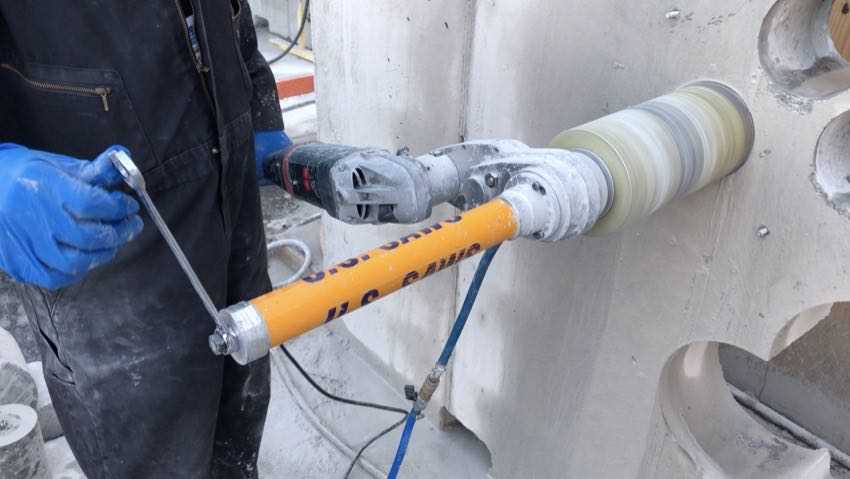
Diamond core bits are the cutting components of the core drill. They are made with industrial-grade diamonds embedded in the tip, which provide exceptional cutting performance and durability. Diamond core bits come in different sizes and shapes, allowing for various hole diameters and depths. They are designed to withstand the heat and friction generated during the drilling process.
3. Water Tank or Water Supply
Water is essential in core drilling to cool down the diamond core bit and flush out the debris. Some core drills come with an integrated water tank, while others require a separate water supply. The water helps in reducing heat buildup, lubricating the core bit, and keeping the drilling area clean from dust and debris.
4. Drill Stand or Rig
A drill stand or rig is used to stabilize the core drill during drilling. It provides stability and precision, ensuring accurate drilling and preventing the drill from moving or vibrating excessively. A drill stand or rig is commonly used for large-scale core drilling projects where precision and control are crucial.
5. Vacuum or Dust Extraction System
A vacuum or dust extraction system is used to collect and remove the drilling dust and debris generated during core drilling. It helps maintain a clean working environment and prevents the dust from spreading and causing potential health hazards. The vacuum system can be connected to the core drill or positioned near the drilling area.
6. Safety Equipment
Wearing appropriate safety equipment is essential when core drilling concrete. This includes safety goggles or glasses to protect the eyes from flying debris, ear protection to reduce noise levels, gloves to protect the hands, and a dust mask or respirator to prevent inhalation of dust particles.
7. Additional Accessories
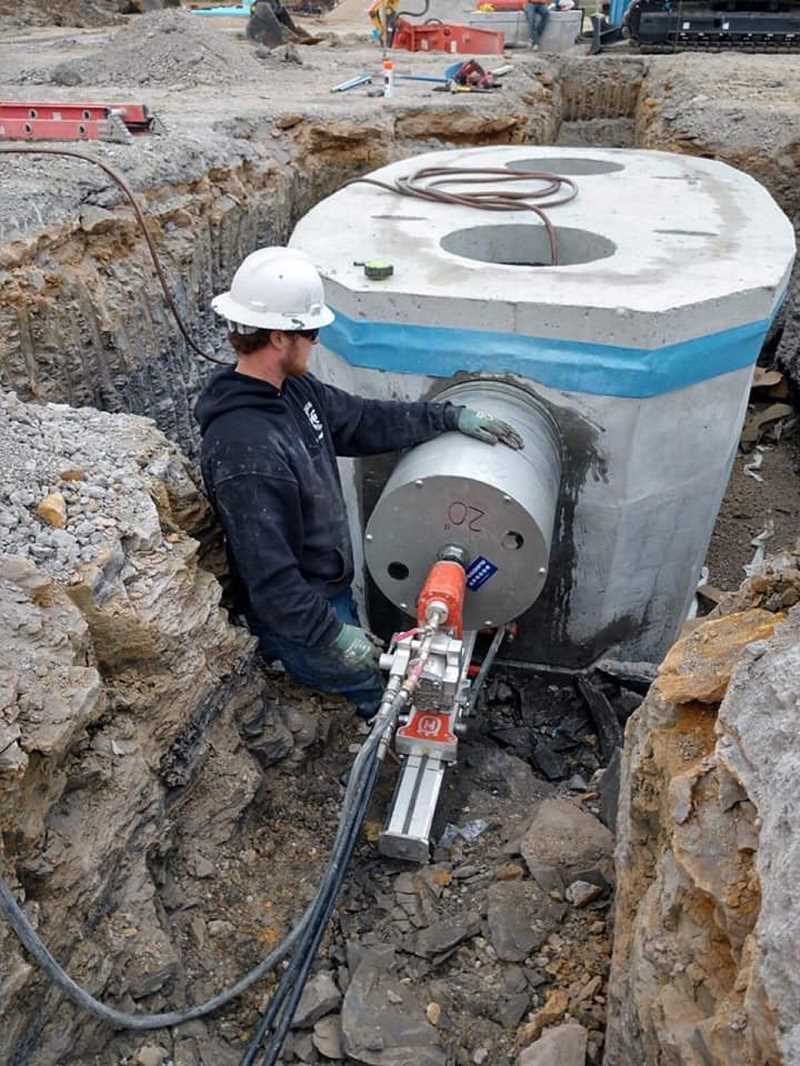
Other accessories that may be needed for core drilling concrete include extension bars for drilling deeper holes, anchor bolts or anchor stands for securing the drill stand or rig to the surface, and a carrying case for convenient storage and transportation of the core drill and accessories.
In summary, core drilling concrete requires specialized equipment and tools such as a core drill, diamond core bits, water supply, drill stand or rig, vacuum system, safety equipment, and additional accessories. Using the right equipment and tools is essential for efficient and accurate core drilling.
Choosing the Right Core Drill Bit
When it comes to core drilling concrete, one of the most important factors to consider is choosing the right core drill bit. The effectiveness and efficiency of the drilling process depend heavily on the type of bit you select.
Diamond Core Drill Bits
Diamond core drill bits are the most common and widely used type of core drill bits for concrete drilling. These bits are made with industrial-grade diamonds embedded in the drill bit’s matrix or segments. Diamond core drill bits are known for their exceptional cutting performance and durability.
When choosing a diamond core drill bit, consider the following:
- Size: Diamond core drill bits come in different sizes, ranging from small diameters for electrical and plumbing installations to larger diameters for larger holes and heavier-duty applications. Choose the right size based on your specific needs.
- Matrix Type: Diamond core drill bits feature different matrix types, such as wet-cut, dry-cut, and laser-welded. The matrix type affects the bit’s performance and lifespan, so consider the material you’re drilling and select the appropriate matrix type accordingly.
- Segment Type: Diamond core drill bits also have different segment types, such as turbo, segmented, and continuous rim. Each segment type offers unique advantages for different drilling applications. Consider the material you’re drilling and the desired cutting speed to select the right segment type.
Carbide Core Drill Bits
Carbide core drill bits are another option for drilling through concrete. Unlike diamond core drill bits, carbide bits use carbide teeth or inserts to grind through the concrete. These bits are generally more affordable and suitable for less demanding drilling jobs.
When choosing a carbide core drill bit, consider the following:
- Size: Carbide core drill bits come in various sizes, just like diamond core drill bits. Select the size that suits your specific drilling needs.
- Tooth Configuration: Carbide core drill bits have different tooth configurations, such as straight, spiral, or square-tooth. The tooth configuration impacts the drilling speed and performance, so choose the right tooth configuration based on your drilling requirements.
- Material: Carbide core drill bits can have different carbide grades for cutting different materials. Consider the type of concrete you’re drilling and select the appropriate carbide grade for optimal performance.
Other Considerations
Aside from the type of core drill bit, there are a few other factors to consider when choosing the right bit:
- Drilling Speed: Different core drill bits have different recommended drilling speeds. Ensure that the bit you choose matches the drilling speed of your core drilling machine for efficient and safe drilling.
- Water Source: Depending on the type of drill bit, you may need a water source for cooling and lubrication. Ensure that your chosen bit is compatible with either wet or dry drilling and adjust your drilling setup accordingly.
- Budget: Consider your budget when selecting a core drill bit. Diamond core drill bits are generally more expensive but offer superior performance and longevity, while carbide core drill bits are a more economical option for less demanding applications.
Conclusion
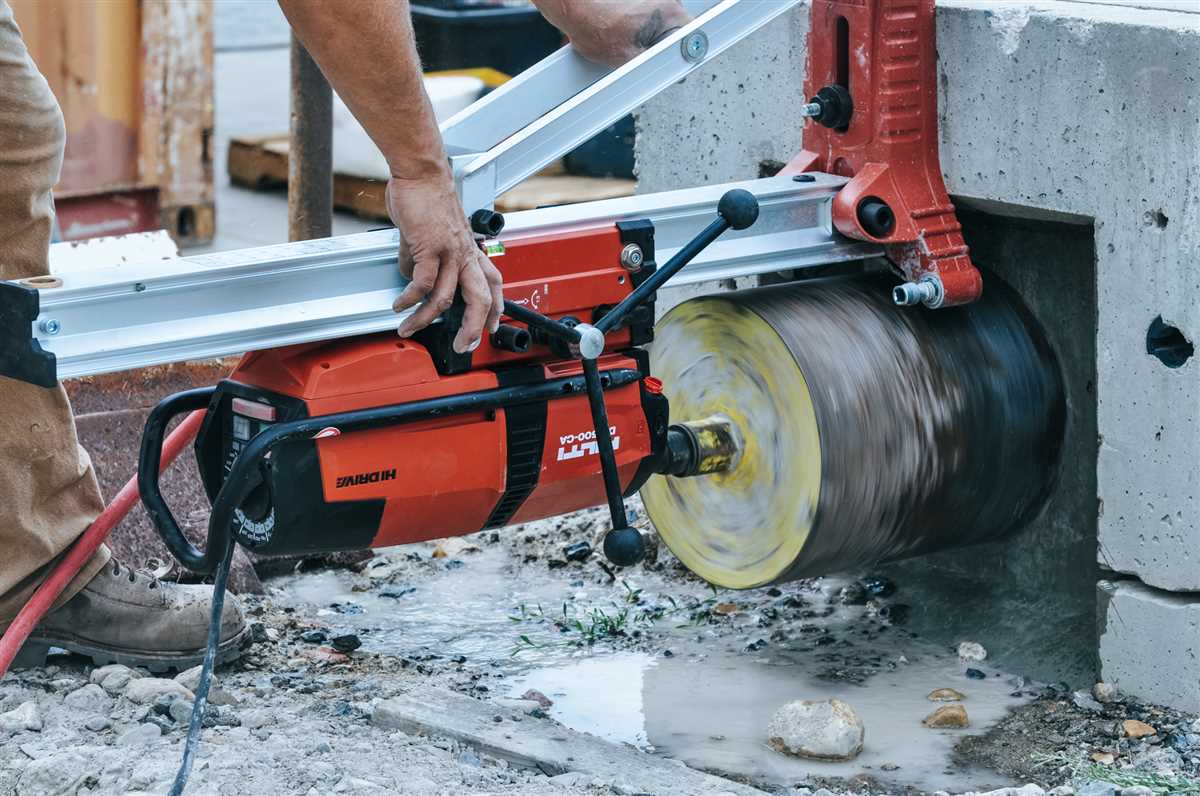
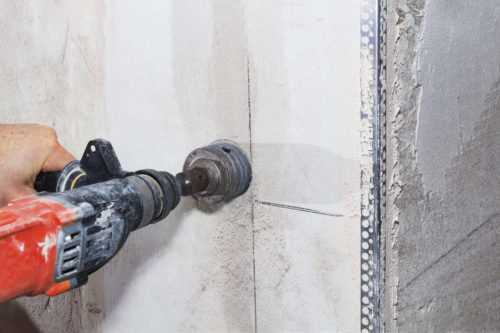
Choosing the right core drill bit is crucial for effective and efficient concrete drilling. Consider the type of concrete, drilling requirements, and budget to select the appropriate bit. Whether you choose a diamond core drill bit or a carbide core drill bit, ensure that it matches your drilling machine’s specifications for optimal results.
Preparing for Core Drilling
1. Assess the Site
Before you begin core drilling, it’s essential to assess the site to ensure a safe and efficient process. Look for any potential obstacles or hazards that may interfere with the drilling operation. Evaluate the concrete structure for any reinforcing bars, electrical or plumbing lines, or other hidden obstructions. This assessment will help you determine the appropriate drilling method and equipment needed for the job.
2. Determine the Drill Hole Location
Once you’ve assessed the site, you need to identify the exact locations where you’ll be drilling the core holes. Use marking paint or chalk to clearly mark these spots on the concrete surface. Ensure that the locations align with your project’s specifications or plans. Take measurements to ensure accuracy, and double-check your markings before proceeding.
3. Gather the Necessary Equipment
Make sure you have all the necessary equipment and tools before you start drilling. This includes a core drill machine, diamond core bits, water supply, dust control equipment, safety gear (such as goggles, gloves, and ear protection), and a back-up power source. Check the condition of your equipment to ensure it is in proper working order. Also, make sure you have an adequate water supply to keep the core bits cool during drilling.
4. Set up Safety Measures
Prioritize safety during the entire core drilling process. Set up proper safety measures, including barricades or warning signs to prevent unauthorized personnel from entering the drilling area. Ensure that everyone involved in the project is wearing the appropriate safety gear, including hard hats, safety glasses, and high-visibility vests. It’s also important to establish clear communication between the drilling operator and other workers on site.
5. Plan for Dust Control
Core drilling can produce a significant amount of dust, which can be harmful if inhaled. Implement dust control measures to protect the health of workers and nearby individuals. Use dust control equipment, such as a vacuum attachment or wet drilling techniques, to minimize airborne dust. Properly dispose of the collected dust and debris to prevent contamination of the work area.
6. Develop a Work Sequence
Create a detailed work sequence or plan for the core drilling project. This plan should include the order in which the holes will be drilled and any specific requirements for each hole. It’s essential to follow a systematic approach to ensure efficiency and accuracy in drilling. Consider the layout of the site, the accessibility of the drilling areas, and any potential challenges that may arise during the process.
7. Communicate with Stakeholders
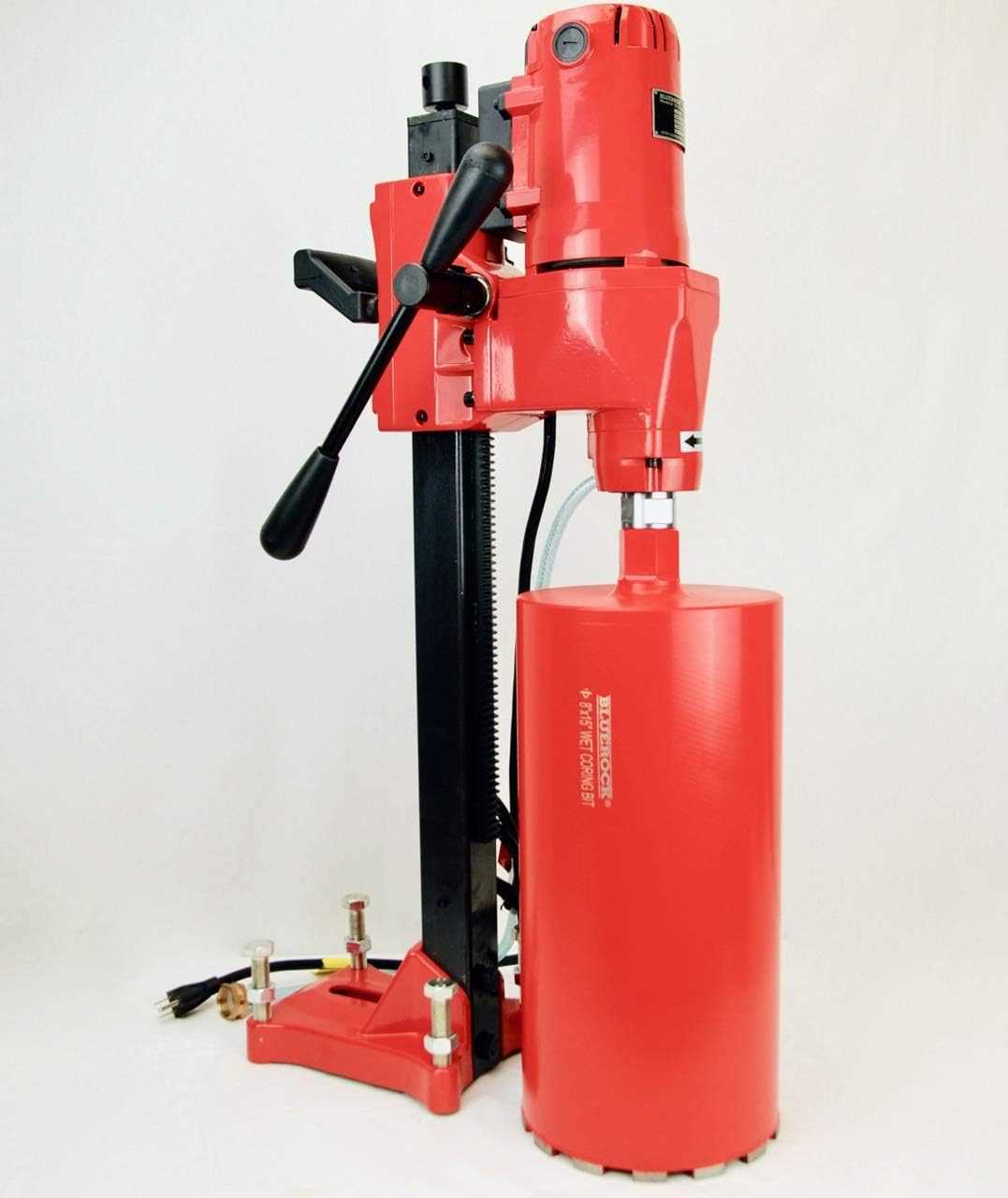
Before starting the core drilling operation, communicate with other stakeholders involved in the project. This could include the project engineer, contractor, or building owner. Discuss the drilling plans and any potential disruptions or safety concerns that may arise during the process. Keep everyone informed and address any questions or concerns before drilling begins.
| Steps | Actions |
|---|---|
| 1. Assess the Site | Identify potential obstacles and hazards |
| 2. Determine the Drill Hole Location | Mark the exact spots on the concrete surface |
| 3. Gather the Necessary Equipment | Ensure all equipment and tools are available |
| 4. Set up Safety Measures | Establish safety protocols and provide safety gear |
| 5. Plan for Dust Control | Implement measures to minimize airborne dust |
| 6. Develop a Work Sequence | Create a systematic plan for drilling |
| 7. Communicate with Stakeholders | Inform other project stakeholders about the drilling plans |
Proper Safety Measures for Core Drilling
1. Personal Protective Equipment (PPE)
Wearing the appropriate personal protective equipment (PPE) is essential when engaging in core drilling activities. The following equipment should be worn:
- Safety goggles or a face shield to protect the eyes from flying debris
- Hearing protection, such as earplugs or earmuffs, to prevent hearing damage from the noise generated by the drilling process
- A dust mask or respirator to prevent inhalation of dust particles
- Steel-toed boots or safety shoes to protect the feet from falling objects
- Heavy-duty gloves to provide hand protection
2. Site Preparation
Prior to commencing core drilling, it is essential to properly prepare the site to ensure optimal safety. This includes:
- Clearing the work area of any tripping hazards or clutter
- Cordoning off the drilling area to prevent unauthorized access
- Securing any loose equipment or tools that could pose a danger during the drilling process
3. Proper Handling and Maintenance of Equipment
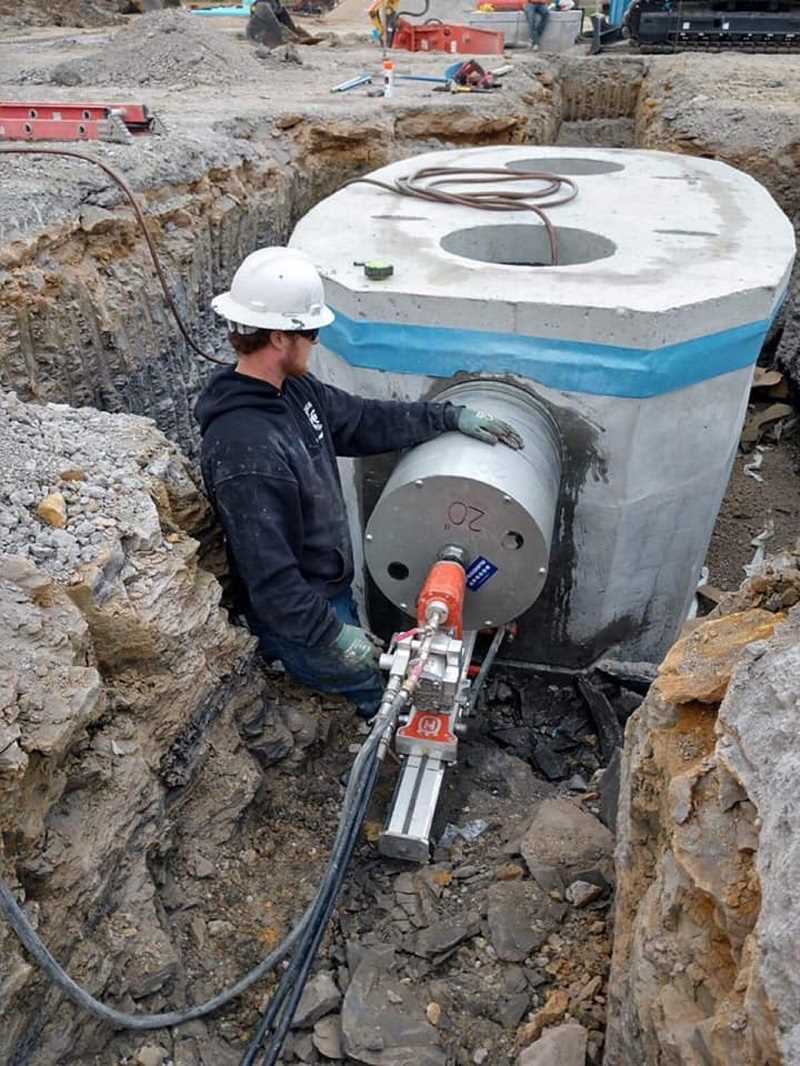
Correct handling and maintenance of core drilling equipment is crucial for safety. The following guidelines should be followed:
- Read and understand the manufacturer’s instructions before operating the equipment
- Inspect the equipment for any visible damage or defects before each use
- Always use the appropriate drill bits and accessories for the specific job
- Ensure the equipment is properly lubricated and kept in good working order
- Do not force the drill or apply excessive pressure while drilling
4. Minimize Dust Exposure
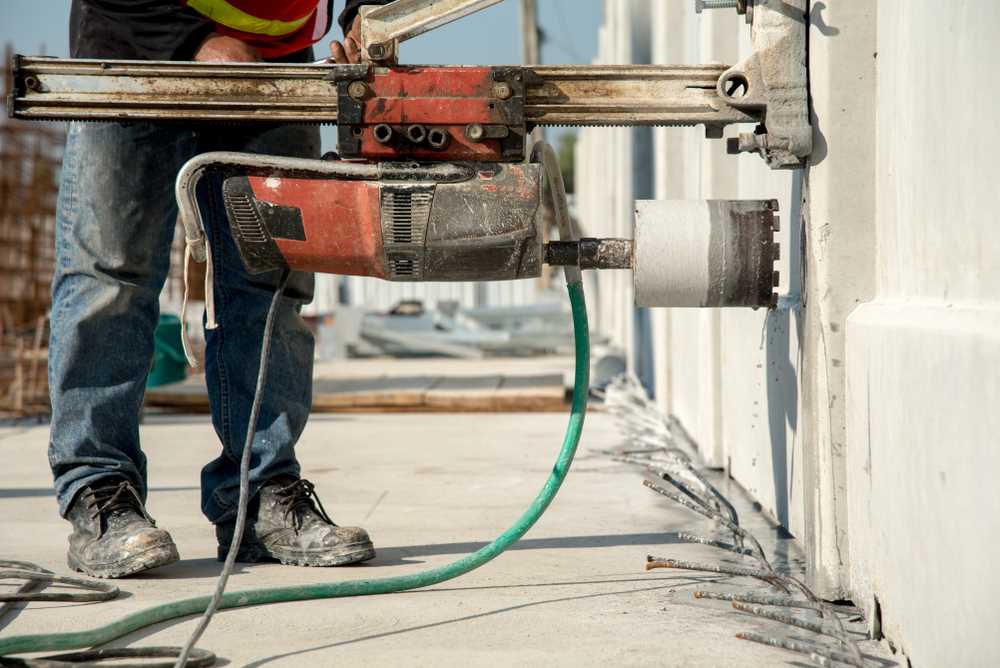
Dust generated during core drilling can pose a health hazard if inhaled. Take the following measures to minimize dust exposure:
- Use a vacuum or water suppression system to control dust emissions
- Wear a mask or respirator that is specifically designed for protection against dust particles
- Work in a well-ventilated area or use a fan to dissipate airborne dust
5. First Aid and Emergency Procedures
Ensure that there is a designated first aid kit on-site and that all workers are trained in basic first aid procedures. In the event of an emergency, such as an accident or injury, follow the established emergency procedures and immediately seek medical assistance if necessary.
Conclusion
Core drilling can be a dangerous activity if proper safety measures are not followed. By wearing the appropriate PPE, preparing the site, properly handling and maintaining equipment, minimizing dust exposure, and being prepared with first aid and emergency procedures, you can ensure a safe and productive core drilling operation.
Common Applications of Core Drilling
Core drilling is a versatile technique that is widely used in various industries. Here are some common applications of core drilling:
1. Construction and Building Maintenance
- Creating holes for plumbing and electrical installations.
- Drilling holes for anchor bolts and dowels.
- Installing drainage systems.
- Creating openings for HVAC ducts and vents.
2. Industrial and Manufacturing
- Creating holes for pipe and conduit installations.
- Drilling holes for cable routing.
- Coring concrete for sample analysis and testing.
- Creating openings for machinery and equipment installations.
3. Infrastructure and Civil Engineering
- Collecting soil and rock samples for geological studies and analysis.
- Creating openings for utility line installations.
- Drilling holes for anchoring structures and foundations.
4. Demolition and Renovation
- Removing concrete sections for renovation and remodeling.
- Creating openings for windows and doors.
- Removing concrete slabs and walls.
5. Environmental and Geotechnical
- Collecting samples for environmental contamination testing.
- Creating boreholes for groundwater monitoring.
- Drilling soil samples for geotechnical analysis.
These are just a few examples of the many applications of core drilling. It is a crucial technique that allows for precise and efficient drilling in various materials, including concrete, asphalt, and masonry.
Tips for Successful Core Drilling
1. Choose the Right Equipment
Before starting any core drilling project, it is important to select the right equipment for the job. Consider factors such as the diameter of the hole, the depth of the hole, and the type of material being drilled. Using the wrong equipment can result in inefficient drilling and potential damage to the equipment.
2. Use the Correct Drill Bit
Selecting the correct drill bit is crucial for successful core drilling. Different materials require different types of drill bits. For example, diamond drill bits are ideal for drilling through hard materials like concrete, while carbide-tipped drill bits are better suited for softer materials. Using the wrong drill bit can lead to ineffective drilling and premature wear on the bit.
3. Prepare the Work Area
Prior to beginning the core drilling process, it is important to prepare the work area. Clear any debris or obstacles that may obstruct the drilling process. This will ensure a safe and efficient drilling operation. Additionally, it is important to secure the workpiece to prevent movement during drilling.
4. Use Proper Technique
When core drilling, it is important to use proper drilling technique to achieve accurate and clean cuts. Maintain a steady pressure on the drill, allowing the drill bit to do the work. Avoid applying excessive force or drilling at high speeds, as this can lead to overheating of the drill bit and potential damage.
5. Take Safety Precautions
Always prioritize safety when core drilling. Wear protective gear such as safety glasses, gloves, and hearing protection. Ensure that the drill is properly grounded and that the electrical cord is in good condition. If drilling into a wall or ceiling, be aware of any potential hazards such as electrical wiring or plumbing.
6. Properly Maintain Equipment
To ensure successful core drilling, it is important to properly maintain the equipment. Clean the drill bit regularly and inspect it for damage. Replace worn-out drill bits promptly to avoid inefficient drilling and potential damage to the equipment. Regularly inspect and lubricate the drill’s moving parts to ensure optimal performance.
7. Plan for Waste Disposal
When core drilling, it is important to plan for the disposal of waste material. Core drilling produces a cylindrical plug of material called a core. Properly dispose of these cores to prevent clutter and potential safety hazards. Consider using a vacuum or dust collection system to minimize dust and debris during the drilling process.
8. Seek Professional Assistance if Needed
If you are unsure about the core drilling process or if you have a complex project, it is always best to seek professional assistance. Professional core drilling services have the expertise, experience, and equipment to ensure a successful drilling operation while adhering to safety standards.
9. Practice, Practice, Practice
Core drilling is a skill that improves with practice. If you’re new to core drilling, start with small, simple projects to gain experience and confidence before taking on larger or more complex projects. Practice maintaining steady pressure, drilling at appropriate speeds, and using proper technique to achieve the best results.
10. Follow Manufacturer’s Instructions
Always refer to the manufacturer’s instructions and guidelines for the specific equipment and drill bits you are using. Following the manufacturer’s recommendations will help ensure safe and successful core drilling results. If the instructions are not readily available, contact the manufacturer or consult a professional for guidance.
By following these tips, you can increase your chances of success and achieve accurate, clean, and efficient core drilling results.
FAQ:
What is core drilling?
Core drilling is a process in which a cylindrical hole is created in a solid material, such as concrete, using a rotating diamond-tipped drill bit.
Why is core drilling used in concrete construction?
Core drilling is commonly used in concrete construction to create openings for plumbing, electrical, and HVAC systems, as well as for sampling of concrete for testing purposes.
What equipment is needed for core drilling?
The equipment needed for core drilling includes a core drill machine, a diamond-tipped core drill bit, water supply, and a vacuum or anchor system for stability.
How does the core drill machine work?
The core drill machine is operated by a motor that spins the diamond-tipped core drill bit at a high speed. The bit cuts through the concrete, creating a cylindrical core that can be removed.
Is core drilling a noisy process?
Yes, core drilling can be noisy. It is recommended to use ear protection when operating a core drill machine.
Are there any safety precautions to take when core drilling?
Yes, there are several safety precautions to take when core drilling. These include wearing protective eyewear, gloves, and a dust mask, as well as ensuring the stability of the drill and using caution when handling the core drill bit.
Video:












